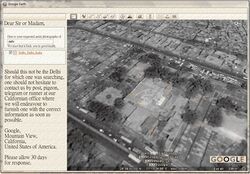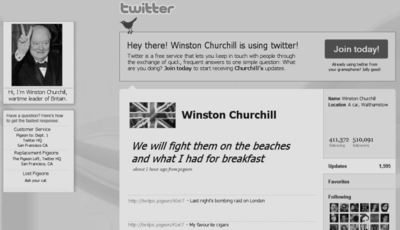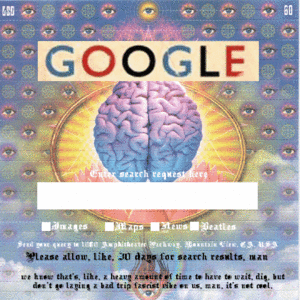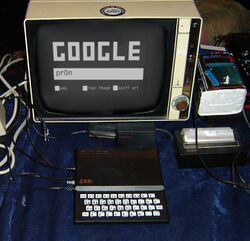History of Google
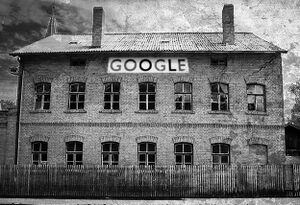
Since it became the world's most popular search engine, many people imagine that the Google™ corporation of California™ is a young company. However, this is not the case. Google was first registered as a trademark as long ago as 1894 and has been in business ever since, though it is only in the last decade that it has achieved the international fame that it now enjoys. The first ten years of the company's history was, nevertheless, also a highly eventful time during which the organisation - which started with just two employees, co-founders Larry Page and Sergey Brin - experienced rapid growth and soon became one of the USA's most profitable corporate entities. Starting off in a small wooden shack, rented from a local farmer, Google soon needed much larger premises due to their rapidly expanding collection of books which were at the time the only reliable method of saving data.
This led in 1897 to the construction of the first Googleplex, as Google's HQ became known, in Mountain View which was, in those days, a small and sleepy town with a population of just twenty-seven people and a horse[1].
- ↑ The horse, one of the nascent company's very first employees, was paid in shares for the second month of work it completed as Google had not made a sufficient amount to pay it in cash. It now lives in a 150 room stable and drives a custom-built Bentley horsebox.
Origins and Early Search Methods
Page and Brin's great epiphany came during the winter of 1893, which they spent smearing one another's bodies with goosefat to combat the extreme cold as was commonly done in those days, when they realised that information was a vital and highly valuable resource in the rapidly industrialising Western nations. At that time, if somebody wanted facts on any subject, the only way to get them was to visit a library and to look it up in a book. Public libraries were in existence but were few and far between, so for the majority of the population that were not lucky enough to have private libraries in their homes this task would in all probability involve a very long and arduous journey.
Contemporary records from the time tells us of several instances in which pioneers in remote parts of the United States, upon finding that their new occupation as a fur trapper was about to come to an abrupt halt due to their lack of knowledge concerning what a beaver looked like and how one might go about capturing such a creature, would have to travel overland to their nearest major conurbation to find the relevant information in an encyclopedia.
In many cases, this would mean a perilous trek over many thousands of miles - at least one trapper walked from Portland, Oregon to New York City where he was able to see a photograph of a beaver and then walked all the way back again, a journey which took over two years to complete and which was made even worse when he arrived back in the north and discovered that during his long ordeal he had become slightly unclear about the precise appearance of a beaver's tail, so he had to start out all over again. The colleagues realized that, if they were to buy a book full of pictures of the various animals unfortunate enough as to be covered with luxurious fur, they would be able to produce copies of the images and provide them by mail and for a small price to anybody who requested information on that species. Before long, it became apparent that people were thirsty for all sorts of knowledge on every subject imaginable and so an entire library, including books on a wide range of different subjects, was established at the company's newly-built Googleplex.
To speed up the service, Google introduced pre-printed standardized search request forms which were made widely available in shops and bars [1] throughout the States. A rare example of one of the original request forms is reproduced on the right hand side of this page. All a searcher had to do was affix a stamp, write his or her address on the reverse of the form and fill out their question in the allotted space. This was extremely effective in streamlining the service provided by Google, and within weeks of the system's introduction anybody could expect to receive a reply to their request within thirty days, no matter what the subject. There was no cost for the service, and Google even supplied postage.
- ↑ Bars proved to be a fertile source of revenue - it was Page's idea to distribute the request forms in bars, because he realized that Google would be an invaluable resource for competitors taking part in quiz nights and for those seeking a speedy resolution to drunken arguments.
Computerisation

Even though Google's new standardised search method was extremely effective, the company soon found itself dealing with a higher quantity of requests than they were able to cope with. On the 1st of October 1900, their Mountain View base received a total of 14.5 million requests through the mail, so many that the US Postal service had to charter a special locomotive pulling seven carriages, all of which were packed full of the six inch by four inch forms.
The company now employed over two hundred people, 95% of whom spent their days running from one part of the library to another tracking down answers to queries - this was, as one can imagine, an absolute logistical nightmare. Mistakes were beginning to occur as it became impossible to keep track of every request, the most notable example of which was the case of a Michigan man named Henry O'Hanlon who requested information on where he might locate a beaver. A tired employee sent him faulty directions, which resulted in O'Hanlon's wife, who was famously unable to be seated during the entirety of the court hearing, demanding a divorce. O'Hanlon later successfully sued Google and was awarded $15,000 which the company had no choice but to pay.
Page believed that the only answer was to relocate to still larger premises and equip a much larger library with at least three copies of every book stored there, which would have allowed the firm to increase employee numbers by 300% which he felt would be sufficient to avoid further problems. Brin, meanwhile, was not convinced. The company had already had to move to a bigger building just a few years previously and it continued to grow rapidly, he argued, so it was entirely possible that were they to do this again, they'd find themselves in the exact same situation before too long. Page realised that his colleague had a valid point, but although they racked their brains to find a solution, none was forthcoming and so it was decided to go ahead with yet another relocation.
However, in the nick of time, the corporation was approached by an independent businessman named Jeremiah Watersnake, a mysterious part-Cherokee half-breed with a taste for strong whiskey and equally muscular women[1]who had secured the sole rights to import and distribute the analytical engines - a form of mechanical early computer - constructed by England's Babbage Company into and throughout the United States after the death of inventor Charles Babbage in 1871. Watersnake was offering Google one of the machines at a cut-price offer of just $20,000[2].
The business partners were initially highly reluctant to get involved with Watersnake, towards whom they both felt instinctive mistrust but allowed themselves to be talked into viewing a demonstration of the engine, one of which had been brought to California especially. Though it seemed impossibly complex to them, they realised that they were now in a financial position that allowed them to hire workers with the necessary skills to operate and maintain such a device. After a brief discussion, during which they realised that the whirring construction - which Watersnake referred to as a computer, a word previously reserved for those who mentally performed computational tasks - was the way ahead and an order for two of the forty ton machines was placed.
- ↑ He was a close personal friend of the distillery owner Jack Daniels and had been romantically linked to "Heavily" Beverley, The Seven Foot Tall, 600lb Weight-Lifting Wonder of P.T. Barnum's Travelling Museum, Menagerie, Caravan and Hippodrome.
- ↑ Equivalent to $20,000 at today's rates.
Google Earth
In 1905, it became apparent that imperialist nations required a method of keeping checks on natives in far-flung outposts of their empires to ensure they were not carrying out subversive acts, such as painting giant penises on school roofs or using weedkiller to write rude words in 50 foot high letters on sports fields, without the expense of sending soldiers overseas.
Quick to spot another opportunity, the company introduced its Google Earth service, which made it possible for anybody to view photographs of the entire Earth's surface taken by a fleet of hot-air balloons; later came the Sopwith Camels aircraft[1]. As people realised that the service also allowed them to spy on their neighbours, it quickly became popular among interested parties from all walks of life as well as with governments.
- ↑ Kind of like a sewing machine with wings attached.
WW1
Though the United States remained largely untouched by the atrocities taking place in Europe, Google - along with many other American companies - tried their utmost to do all they could to offer aid to Britain in its attempts to thwart the Kaiser's imperialistic ambitions. One of these policies was their pledge to put aside several thousand dollars each year which would be used to purchase and supply specially produced high-definition binoculars which would enable British military forces to keep a watch for the dull, leaden grey Zeppelin bomber airships in their nation's perpetually dull, leaden grey skies.
Later on during the war, as Britain began to suffer from food shortages, the company searched for an edible substance which would be able to survive the long journey across the Atlantic without the need for refrigeration. Unsuccessful in their efforts to find a suitable candidate, Google established a laboratory and staffed it with food scientists who, in 1916, developed the ideal product - a high-calorie cake bar with a shelf-life in excess of forty years which later became known as a Twinkie[1].
Several million of them were shipped to the beleaguered islands, but the project met with limited success as the British did not at first recognise the bars as food and as a result the majority of the first few batches were used a substitute construction material in place of bricks to repair homes and civic buildings damaged by German explosive devices.
A Dark Period in Company History
Google's records reveal a period in the company's history that took place in the years shortly after the war which staff still prefer not to talk about. A number of documents still exist which show that, during the 1920s and 1930s, the corporation received a very large number of search requests that originated in Germany, amongst them a great many on the topics of re-armament and, most chillingly, the now largely discredited science of eugenics. One terrifying example reads Vot ist der solution to der Juden problem?
Google has always had a policy of offering only optional search filtering, and as a result of this the person that made the request was sent copies of information from an 1883 book titled Die Endlösung, written by Sir Francis Galton[2], the cousin of Charles Darwin.
- ↑ Margaret Hillingsdale, lecturer in Cake History at Cambridge University, recently discovered and consumed a Twinkie known to have been produced in 1918 with far fewer ill effects than any of her students predicted. She still died, though.
- ↑ It remains an unexplained mystery why Galton, an Englishman, should have chosen to give his book a German title.
The Great Depression
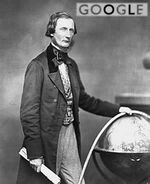
Google had gone from strength to strength, and with their adoption of newly available computer technology it seemed that the company would grow even more. By 1920, just a short while after the First World War came to a conclusion, Page and Brin employed around 10,000 staff and were the proud owners of fifteen analytical engines, more than 60% of the world's total - they had originally owned sixteen, but one was subsequently sold to Thomas J. Watson Sr. of the Computer Tabulating Recording Corporation, later to be renamed IBM, who was attempting to reverse engineer the device in order to be able to produce a cheaper, more portable version of his own[1].
Then, in 1929, Wall Street crashed, plunging the entire world into the Great Depression. Google was forced to lay off seven out of every ten of its employees, the company's stock was dramatically slashed in value and profits dropped through the floor. In 1930, for the first time in its corporate history, Google recorded a loss as it discovered a $10,000 hole in its finances and it looked very much as though they were finished. Page and Brin considered selling off the analytical engines and downsizing to smaller premises where they planned to return to the much cheaper old methods of using humans to retrieve requested information from a library[2]. Whether it was Page or Brin that suddenly, in a flash of inspiration, saw the way out has not been recorded in the company's history[3], but whoever it was demonstrated remarkable insight.
The demand for information, they realised, is not decreased during economic downturn - all that happens is that the type of information deemed most useful by most people changes dramatically. For example, instead of What can I buy for my mistress from the new Tiffany's range or New European Luxury Cars, a common request might be What's the best way to disguise the pungent flavour when cooking a sewer rat or how can I prevent my six-month-old baby from coughing up blood, even though I have no money for medicine and no medical insurance? It soon became apparent that if search requests could somehow be made free of charge, the company would in all probability receive even more of them since most people had been forced to burn all their books just to try to keep hypothermia away during the previous winter and as such would now rely on Google for all of their information requirements.
It was during this time that many companies realised the absolutely vital importance of advertising, since they were in desperate need of any business they could possibly find - anyone who has ever studied business will be well aware that the only companies to have survived the Depression are those that increased their spending on advertising[4].
Page and Brin immediately approached a number of outside companies, offering them advertising space at highly competitive rates. The search request forms were not altered in order to keep the user-friendly, uncluttered look which surveys had revealed was one of the most appreciated and best recognised features of the service but the paper upon which replies were printed was increased in size and from then on featured a number of adverts which could be tailored so that they would be related in some way to the topic.
As a result, sending off a request form asking for information on beavers would result in the sender receiving a letter which in addition to information on and pictures of beavers, would also include adverts for companies that supplied either beavers[5] or beaver-related products[6]. This new policy brought the company back from the brink of financial disaster, enabling them to re-employ all those workers made redundant and to return to using the full quota of analytical engines, eleven of which had been put into storage.
As a result, Google was one of just a handful of companies throughout the world to announce that they had made a profit during 1931 - what's more, theirs was the highest of those recorded, at some $900,000[7]. They were also the only corporation in the entire United States to actually emerge from the Depression with a larger number of employees than that with which they had entered the economic crisis.
- ↑ This was achieved, allowing them to introduce their revolutionary Personal Counting Device or PCD which, at five tons, was less than half the weight of a Babbage analytical engine. However, it lacked certain features fitted as standard to the Babbage machine, such as a 17" LCD monitor and 512 megabyte graphics card.
- ↑ In modern times, with cheap computer power, this system would be magnitudes costlier than a computerised, automated system. However, during the 1930s there was no minimum wage and so humans could be hired cheaply and would cost far less to maintain than machines. Also, black people had no rights at all at that time and as a result could be employed to perform hard physical tasks for virtually no pay at all.
- ↑ Leading some observers to wonder if it was actually that of an employee, whom they sought to prevent benefitting from the idea.
- ↑ They'll be aware of this because business studies lecturers are required by law to repeat it a minimum of fifty times per day; a bit like English teachers have to write Ghoti on the blackboard and ask pupils what it says and physical education teachers have to commit acts of gross physical and/or mental cruelty upon fat children.
- ↑ Such as Craigslist of San Francisco.
- ↑ Such as Ann Summers of Whyteleafe, Surrey, England.
- ↑ Compared to the next highest, $100,000, recorded by the Alabama Snakeoil Company which sold spurious cures for a range of malnutrition-related illnesses such as rickets.
WW2
During the Second World War, it became apparent that Hitler and the Nazis were using Google in order to collect classified information to further their war effort. As an example, the German High Command were very nearly successful in assassinating British leader Winston Churchill in 1941 after a simple search request revealed his whereabouts - information that should, of course, have been a closely-guarded secret and which would have remained so had Churchill not felt unable to disappoint his legions of followers on the then relatively newly-established Twitter service[1]. As a result, he regularly provided updates to allow people to know where he was and what he was doing, against advice given to him by Secret Services.
When German agents posted a request form asking for information on Churchill on the 27th of May, they were stunned to receive a recent update from the great man in amongst the hundreds of links to Churchill Insurance which informed them that he was currently in the back of a plain Morris automobile travelling through Walthamstow en route to the House of Commons[2], but had become stuck in heavy traffic. Nazi commanders immediately passed on the information to secret agents active in the North London area, one of whom was able to quickly locate the car and fired several shots from a snub-nosed machine gun into the rear passenger compartment. Churchill survived unscathed by sheer luck - he could very easily have been killed, which would have plunged Britain into a state of confusion and despair that may well have given Germany the upper hand and altered the ultimate outcome of the war.
To ensure that this disaster would never have a chance to happen ever again, Google invested a great deal of time, effort and money into the development of revolutionary new search algorithms which were intended to detect search requests originating from hostile nations, while still allowing users from the Allied countries to continue using the search engine as normal. It took months for engineers to come up with a working prototype, during which time Churchill's loyal fans had to make do without Twitter updates, but in September 1941 the new algorithm was finally ready and was put into action. Like many great inventions, it was in fact deceptively simple.
Google looked at the syntax structure of millions of American and British search requests, and compared them closely with those thought to have been made in Germany, Italy and Japan or by enemy agents masquerading as friendly resistance forces in those countries occupied by the Reich. It soon became apparent that there were obvious structural differences, and based on this finding it was possible to write a code which could recognise an Allied request - such as Where is Churchill? - from one made by an enemy, for example Vere ist der Inglisher schweinhund Churchill?
Once the algorithm had detected that the request was enemy in origin, it would prevent the user from viewing any information on the Prime Minister and instead redirect the request to Churchill Insurance's Request More Info option, thus causing them to receive vast amounts of junkmail, rapidly filling their letterboxes with useless waste paper. This largely-forgotten action has been credited as one of the most decisive acts in the Allies' favour during the whole of the war, as it is known to have caused great headaches and annoyance to the Nazi forces who eventually abandoned this method of intelligence gathering, which had previously been highly effective, and instead had to rely on guesswork.
- ↑ Mobile telephones had not been invented at the time, but Twitter (beginning in 1927) was nevertheless a very popular service and already rated as the third most used social networking site after Facebook (1912) and MySpace (1920, when Tom was just 17. A bug, located in the part of Tom's profile that gives his age, is the reason that many MySpace profiles list their owner as being 106 years old, which is Tom's current age). Rather than SMS text messaging, users would compose short messages known then and now as tweets which would then be converted into Morse code ticker tape messages. These would be attached to the leg of a carrier pigeon - users would commonly keep two or three of these birds about their person at all times - and the message would, via a series of relays where it would be swapped from the leg of a tired bird to a fresh one, eventually make it to Twitter HQ in San Francisco, USA. Copies of the message would then be made and attached to further pigeons, with the necessary number depending on the number of followers subscribed to the message creator's profile. Each copy would then make its way, via the same system of relays, to each subscriber. In comparison to today's high-tech communications, with instant messaging commonplace, the method seems highly labourious but in practice it was very effective. There are records to suggest that when the service was working at maximum efficiency - and there were prevaling winds travelling either way across the Atlantic Ocean at various times of the day, tweets could pass between the USA and Europe in a matter of just weeks. Internal tweets, such as that sent by Churchill to his followers, could take less than an hour.
- ↑ Because the Commons Bar - the only licensed premises in Great Britain not affected by the rationing of beer and other alcoholic beverages during the war - was just about to open.
1945 - New Leaders
At the end of WW2, Page and Brin realised that the company they had formed and steered to success was entering a brave new world, in which everything they had previously known would rapidly change or vanish to be replaced by the new. They had led Google for just over half a century and felt that it was now the time to hand over the reins to a new generation. Both men had married and had sons who worked within the organisation, Larry and Sergey Jnr., albeit in relatively lowly positions (they made the coffee)[1].
During a board meeting, Page and Brin, who were now old men, announced to their employees that Larry and Sergey Jnr. would soon be taking over as joint CEOs of the firm. The co-founders would, however, retain consultancy contracts and would work in advisory positions in order to prevent share values from dropping rapidly.
The Golden 1950s
As the rest of the world began the slow and painful task of rebuilding civilisation, smashed by the horrors of the greatest war ever seen, the USA - the only nation to come out of WW2 having made a profit - entered a period of prosperity the likes of which had never before been seen. European soldiers returned home to bombed-out ruins and, for those whose families had not been entirely wiped out, maimed wives and children. American soldiers went home and found glowing[1], healthy wives, well-fed offspring and 40 foot long Chevrolets with fins on the back waiting for them.
Google was, of course, not alone in enjoying success and profitability beyond Page and Brin Snr.'s wildest dreams as every US corporation recorded record growth during the decade[2]. Life as a Google employee seemed idyllic, and few were prepared for the shake-ups to come in the following decade.
- ↑ As in glowing with happiness and vitality, not as a result of the Manhattan Project's atomic bomb tests. At no point were white women used as test subjects by the US Government.
- ↑ As did US waistlines - it was during the 50s that the average American began piling on the pounds as they fed on a fat-rich diet of hamburgers and corndogs, eventually achieving the extreme obesity that makes them the envy of the world to this day.
The 1960s, Man
The swingin' 60s were great years for Google, a decade in which automated data searches really came into their own as, worldwide, people wanted information on the most recently discovered psychoactive substances, whether or not smoking banana skins really got you high and The Beatles. Recognising a money-making opportunity when they saw one, Page and Brin Jnr. turned on, tuned in and sold advertising space to underground pharmaceutical companies.
During 1967, a rumour began to circulate that every Google search request form including one square centimetre of paper that had been impregnated with LSD. So widespread did this urban legend become that hipsters at every gathering in every village, town and city on the face of the Earth - with the exception of Amsterdam, where LSD could be bought in sweetshops - were licking more forms than they put in the post. Google decided that it was within the company's interests to prevent this myth from being disproved, which would cause it to gradually die out and thus deny them the exposure and free word-of-mouth advertising to which it amounted.
As a result, from January 1968, secret Google agents were sent out into communities where they would infiltrate youth groups, live music clubs, communes, festivals and assorted hippy events and, once accepted by their peers, would start to pass on stories of how fictitious friends in San Francisco (or other hippy strongholds) had claimed that the LSD on search forms was by far the most powerful, intense, meaningful and mind-expanding they had ever experienced. Page had an idea to recruit John Lennon, a well-known hippy style icon mercenary enough to do just about anything for money [1] and have him star in a television advert in which the Beatles frontman would claim to have enjoyed a trip involving shamanic flight, a tea party attended by Jesus, Buddha, Gandhi and a troupe of performing glow-in-the-dark badgers after licking one of the forms[2].
The advert seemed ready to get the go ahead when Lennon, who in line with his working class hero image now lived in a vast mansion and drove a Rolls Royce, suddenly refused to take part unless he was paid $10 million. Nowadays, Google is such a rich and successful company that sums of this magnitude can be found in the staff's petty cash tin, but back then it was considerably more than they were either able or willing to pay. The advert was doomed from this point on, and was never made.
It was Brin who came up with an affordable, and altogether more effective, alternative during a board meeting. LSD was, back then, very cheap and the company's bargaining power gave them the ability to purchase a container truck full of it direct from Albert Hoffman's laboratories in Switzerland. The request forms were radically redesigned and, from then on, each one really did contain a single drop of pure LSD. Demand multiplied overnight and by the end of the year over 30 million of them were being produced and distributed around the world each month.
Internal Strife
The 1960s were not all wholesome fun and games in Mountain View, however. A Google employee named Jeeves, who had previously been employed as a butler at Page Snr.'s mansion, staged a hostile bid to take over control of the company which he felt was being over-run by black employees. Believing that he had heard hidden messages in The Beatles' hit record Helter Skelter, he and a group of similarly disaffected cronies occupied several offices and began firing potshots at other employees as they enjoyed their lunch in the organisation's landscaped grounds. Police were called and a siege situation developed, with Jeeves' gang remaining holed up in the buildings for nearly three weeks. Eventually, they demanded a helicopter which the authorities had no choice but to agree to, and they flew into the Mojave desert. The gang seemed to disappear and most people assumed they had succumbed to the desert's harsh conditions.
Then, in 1969, a rival data retrieval firm named Ask began distributing search request forms of their own. Although this company enjoyed some commercial success, they were never able to operate on Google's level and as such remained far less priftable. However, Ask.com was to remain an irritating thorn in Google's side for many years to come.
- ↑ Such as marrying Yoko Ono in order to win a bet with Paul McCartney who offered him five shillings if he'd marry the most harpie-voiced hag they could find.
- ↑ Hippies will believe any old shit - hence the crystal healing and all that crap.
The 1980s
The Home Computer Revolution
With the 1980s came the advent of the home computer. British genius and inventor Sir Clive Sinclair began producing his ZX80 and ZX81 computers (known by some other name in the USA) during the early years of the decade and enjoyed excellent sales, with the result that by 1983 99% of British households owned computers of their own. It wasn't long before David Lightman, a remarkably gifted programmer, discovered that it was possible to hook one up to the telephone network and theoretically transmit and receive data via the phone cables [1]. He realised that the best way to attract attention to his discovery was to announce to the world that, if they did the same with their ZX81s, they would be able to view a picture of a woman with no clothes on which he had created with the machine's phenomenal graphics capability and stored on a C90 audio tape. The Internet had been born.
Google soon realised that they were ideally placed to be able to take advantage of the new popularity of computers in the home and rapidly set about recruiting new employees with the ability to create BASIC software which would allow ZX81 owners to access the company's vast data stores. However, the logistics of the project were daunting - Google's library now numbered some 200 million books, with volumes of every conceivable subject, which would have to be digitised and stored on cassettes with 3.81mm magnetic tape which were, at the time, the most practical form of mass information storage. Originally, the plan was to use the new C120 tapes which had been designed to store one hour of music on either side, but due to their 9 µm tape thickness, which tended to result in tape stretching or breakage, this was abandoned in favour of the more reliable C90 cassette which allowed for storage of around 660 kilobytes of data either side.
Google invested in 4000 ZX81s, making them Sinclair's biggest customer by far[2], which were installed in a specially-constructed facility at the Googleplex.
When a search request was made, it would be put through to one of these computers and would appear on its television screen monitor. A human operator would note down the details and then select the relevant cassette from the alphabetically-arranged library - home to several hundred million cassettes - then take it back to their workstation where it would be inserted into the tape player connected to the computer, allowing the user to view all information recorded upon it. The operators, who prided themselves on the efficiency of their service, often boasted that a search request could now be completed in as little as 30 minutes.
Computerised Search Filtering
During the same year, Google was also forced to introduce search filtering to its new online service. This was brought about after several users complained image request searchs had returned a picture they claimed was highly offensive. The company investigated and discovered that an unknown programmer had utilised Lightman's technology to create the world's first shock image which depicted a sexually-aroused man using both hands to hold open his distended anus. The new filtering function was, in common with all of Google's features, highly user-friendly and extremely simple - with just a few clicks, the user could set the search engine to filter out images with an adult theme which would then not appear amongst the search results. Realising that many people wanted to see images of this type, Google elected to make the search filtering optional, much as it had done with its post-based information delivery service.
- ↑ Theoretically because nobody else was doing it yet.
- ↑ Even this order was insufficient to secure Sinclair's future, however, as they were soon superceded by Japanese companies who produced superior, cheaper machines. Sir Clive Sinclair, founder of the company, now spends most of his time in his garden shed where he invents electronic motors that can be strapped onto bicycles (the motors, which triple the weight of the bicycle once fitted, allow a top speed of 12mph and are fitted with batteries capable of providing power for as much as three miles before requiring a 20 hour charge; so all in all they pretty much remove all the positive aspects - low cost, environmental friendliness and simplicity - of using a bicycle as transport) and drinks lots of milky tea.
The 1990s and Beyond
By 1991, 99% of all search enquiries made through Google were completed via the company's computerised online service which had by now been fully automated, a feature made possible by hard disc drive space now retailing at as little as $7 per megabyte with forecasts predicting costs as low as $6 per megabyte by the end of the decade. As a result, it was decided to discontinue the search-by-post facility early in 1992, at which point the company existed purely as an online entity.
Internet porn came into its own[1] during the early years of the 90s as the new hard discs made it possible to store large amounts of high quality imagery and it was soon estimated that around 75% of all Google searches were made in order to find explicit material. By late '93, searching for porn would deliver around 1000 results, a figure which grew rapidly. By 1994, it had increased to half a million, eventually rising to a million by 1999 (the figure currently stands at 232 million). As a result of this phenomenon, Google decided to adopt the image search system, which had been a feature of the postal service since the latter years of the 19th Century, into its online service where it rapidly became the most used Internet search option in the world.
Despite the ability to provide answers to any conceivable question, Beaver was still the most common search request received by the organisation and remains so to this day, though it was briefly eclipsed during 1998 by Pamela Anderson sex tape.
China
Google launched in China during 2005. Despite rapid industrialisation, the nation's infrastructure was still incapable of supplying the amount of electrical power required by the servers used by Google; which, for a while, looked as though it might prevent or at least delay the company's establishment. However, keen to attract a foreign investor of such repute, the Chinese government made a deal, settling for a reduced service and Google installed the 1980s ZX81 system, which had been mothballed since the late 1980s, in a converted pig product processing facility located in Beijing.
Although this was not capable of delivering the full Google service to Chinese users, it nevertheless worked extremely efficiently, which resulted in Google China deciding to remain with the tried-and-trusted, if slightly out-dated, technology to this day - detractors have claimed that Google is colluding with the Chinese government, thought by many Westerners to be oppressive, in deliberately preventing the country's users from accessing sites not approved by the authorities. However, though Chinese users will have far fewer results for each search request they make, thus far they seem content with what they have and there have been no complaints. The company's public relations are keen to point out, in view of these facts, that Google has not in any way deviated from its rigorously-upheld Don't be evil ethic. In 2009, in response to the Chinese authorities' attack, Google closed the ZX81 server system down, which is considered as inefficient, and redirected traffic to Hong Kong with its Western-built server system.
Controversy and Conspiracy Theories

As is typically experienced by any corporate organisation that records profits greater than around $5000 per annum, Google has been accused of various ill-defined nefarious activities by a number of different groups. Chief amongst these is that the company is attempting to covertly attain control over world politics and the economy in order to further some mysterious ends of its own, a rumour that started in 2002 and was eventually traced to Ask.com, who had also become solely an Internet service - the same company that had been established shortly after the armed siege at the Googleplex in the late 1960s.
Further investigation revealed that Ask was wholly owned by ex-Google employee Jeeves, who had vanished from the public eye and whom was still wanted for questioning by the FBI in connection with this incident and the murder of Sharon Bait, pregnant wife of Hollywood film director Norman Lopanski, at her Los Angeles home during which one of the vicious gang wrote the word GIG in the victim's blood on the property's front door; an aspect of the crime explained by police detectives as a reference to a 1 gigabyte server Ask was planning to purchase, which would have given them a competitive edge over Google who at the time had a mere 320 megabytes. Jeeves was originally sentenced to the death penalty for the murder, though this was later altered to life imprisonment when the State of California temporarily abolished the punishment and he has resided within the Corcoran State Prison ever since. Ask.com still exists but never managed to catch up with Google, who have gone from strength to strength and are now listed as one of the world's largest corporations.
- ↑ "Came into its own" were words often used to search for the period's most popular porn requests.
See Also
| Featured version: 6 May 2009 | |
| This article has been featured on the main page. — You can vote for or nominate your favourite articles at Uncyclopedia:VFH. | |


